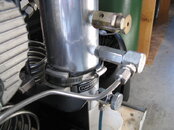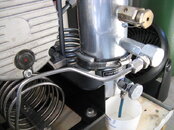pescador775
Contributor
- Messages
- 2,652
- Reaction score
- 14
No, Hacker, 1/4 NPT used to be pretty common in Germany and was used in the Bauer some years ago. Not sure about current practice. The valve fittings screwed into the secondary coalescers were probably some kind of BSPT or Whitworth. The threaded boss had an extreme taper which locked up abruptly when sealed. There is a BSPT which looks a lot like metric and similiar to ANSI in some sizes. If I remember correctly, the valley angle (notch between thread) of the British pipe thread is 55 deg where metric and US uses 60 deg. I haven't had much luck screwing a 1/4 inch NPT into a Whitworth 1/4 inch size. At least I think that was what I was dealing with. It also could have been one of the Euro 7-1 metric threads. Anyway, I removed the gauge from a DIN tank pressure gauge (tank checker) and tried to install a 1/4 inch NPT fitting into the body and it would only take up a couple turns before it became apparent that it would not fit. I got a machinist to make a fitting that would screw into the gauge body. He had to special order the die. I know the guy has metrics so it was probably British. He said "Whitworth".






